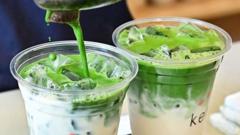The insatiable global thirst for matcha is leading to severe shortages and an upsurge in prices for the vibrant green tea, which has become a trendy ingredient in various food and beverage offerings around the world. The matcha phenomenon, largely fueled by viral social media posts, has seen the hashtag "Matcha Tok" accumulating tens of millions of views, underlining its popularity.
Japan's tourism resurgence post-pandemic and the depreciation of its currency have only intensified demand for matcha products. Lauren Purvis, an American tea importer, reports that her clients are rapidly depleting supplies, with some cafes requesting up to a kilogram of matcha daily to keep pace. However, the confluence of surging demand and challenges such as extreme weather affecting crop yields and US tariffs is driving prices upward.
Traditionally made from shade-grown tea leaves known as tencha, matcha is revered for its health benefits, caffeine content, and unique flavor profile. The labor-intensive cultivation process has faced hurdles of late, as scorching temperatures have hampered harvests, particularly in Kyoto, a region recognized for its matcha production. Compounded by an aging farming population with insufficient recruitment of young workers, availability is dwindling.
In response to increasing demand, retailers in matcha-centric regions are imposing purchase limits. For example, the Camellia Tea Ceremony in Kyoto restricts purchases to one tin per customer as visitor numbers surge, causing shelves to empty promptly upon opening. Tea master Rie Takeda from the Tokyo-based Chazen chain observes delays in order fulfillment, with delivery times extending beyond the usual timeframe, prompting several price increases.
Despite the adverse conditions, demand for matcha presents an opportunity for cultural dissemination. Ms. Takeda acknowledges the growing interest that could lead to a broader appreciation of Japanese customs. With matcha production nearly tripling between 2010 and 2023, and green tea exports swelling by 25% last year, the trend is encouraging to many, while also raising concerns over responsible consumption.
Amidst the hype, activists urge potential customers to avoid hoarding and advocate for mindful consumption. The Japanese Global Tea Association promotes the use of lower-quality matcha for cooking to preserve the integrity of high-grade varieties. Tariffs on Japanese imports, such as the impending 15% import tax from the US, are anticipated to further inflate prices, pressuring distributors like Purvis, who highlights a significant spike in orders as the tariff deadline approached.
While current conditions indicate continued price increases, some industry insiders are optimistic that the market will stabilize in the coming years. Masahiro Nagata of Matcha Tokyo believes that escalating prices for lower-quality matcha will eventually prove unsustainable, predicting a normalization of demand patterns in a couple of years.




















